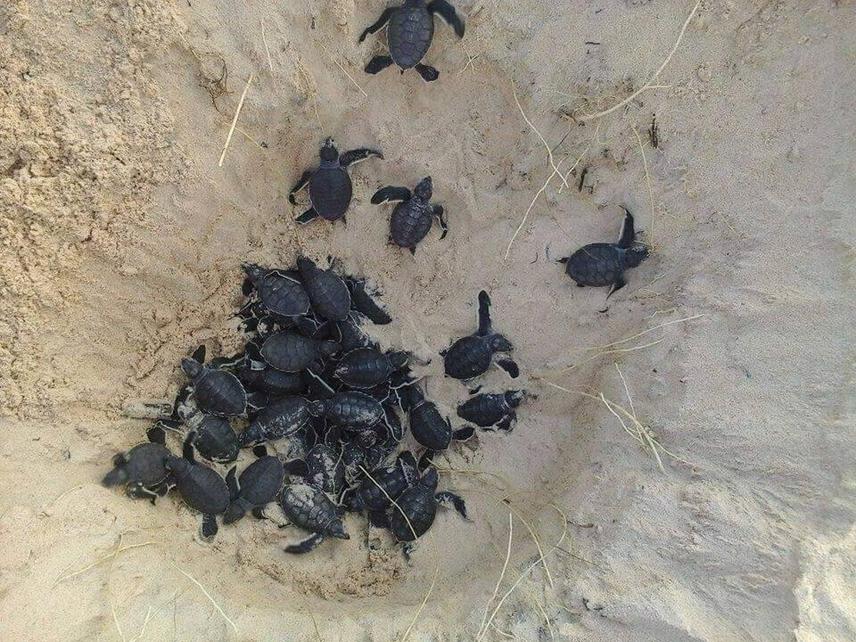Press release regarding the project.
African Network Protects Key Turtle Sites
A network of West African Marine Protected Areas (MPAs), the RAMPAO, that runs along the coast of seven countries, from Cape Verde to Sierra Leone covers key sites used by green turtles, new research shows.
In the study, researchers tracked 45 female green turtles from Poilão Island, in Guinea-Bissau’s Bijagós Archipelago, which hosts the largest population for the species in the Eastern Atlantic Ocean.
The tracked turtles were found to spend most of their time during nesting and foraging periods inside the MPA network.
However, just 21% of key "migration corridors" are protected.
The study was carried out by a team of researchers from the University of Exeter (UK), MARE - ISPA, Instituto Universitário (Portugal), the Institute of Biodiversity and Protected Areas (Guinea Bissau) and the Banc d'Arguin National Park (Mauritania). Additionally, young people from the local Bijagós villages were engaged in fieldwork activities.
"RAMPAO is a great example of an MPA network, with good connections between the MPAs and strong links between the organisations that oversee them," said Dr Rita Patrício, of the Centre for Ecology and Conservation on Exeter's Penryn Campus in Cornwall, and MARE.
"West Africa has very rich marine ecosystems. Conservation efforts in the region were initially focussed on key habitats, such as seagrass beds, mangroves and estuaries and intertidal flats, which are used by populations of global importance of coastal and seabirds, and by charismatic species such as humpback dolphins, West African manatees and green turtles.
"Our study is part of wider efforts to discover where species are distributed in the region, to ultimately find the most effective ways of protecting them.
"Green turtles have complex life-cycles, involving large-scale migrations between breeding and feeding sites.
"It is essential to understand the connectivity between these areas, to estimate the level of protection, and to ensure that conservation efforts on breeding sites are not cancelled out by a lack of protection at feeding sites, and vice-versa.
"In the case of green turtles, our study shows the MPA network in the region covers almost all marine areas used during the nesting period and most feeding areas too. This is hugely encouraging.
"Our finding that most key corridors used by the turtles currently fall outside the MPA network suggests there is an opportunity to increase protection even further."
During the nesting period, turtles spent an average of 95% of their time within the limits of the MPA network, and among the 35 turtles successfully tracked into the foraging period, 28 of them used waters within MPAs.
Key migration corridors were mostly located close to the shore, where regionally important fisheries activities can make effective marine protection more challenging.
Dr Patrício said green turtle populations in this region "look stable" – but this is "conservation-dependent".
"If you remove the conservation effort, the population could drop very quickly," she said.
The United Nations global target to protect 10% of the world's ocean by 2020 was not achieved, but the coverage of protected areas is increasing – and there are now calls to protect 30% of the ocean by 2030.
Balancing marine protection with the needs of human coastal communities is vital, and Dr Patricio said a key goal is to bring all parties together to improve conservation in a way that works for people and ecosystems.
Funders of the research included the MAVA Foundation, the Regional Partnership for Coastal and Marine Conservation (PRCM), the La Caixa Foundation and the European Commission.
The paper, published in the journal Frontiers in Marine Science, is entitled: "Green turtles highlight connectivity across a regional marine protected area network in West Africa."
Ends
Media contact: Rita Patrício, [email protected]
Interviews: Rita Patrício
Scientific article title and link: Green turtles highlight connectivity across a regional marine protected area network in West Africa.
Acknowledgments This project has received funding from the European Union’s Horizon 2020 research and innovation programme under the Marie Skłodowska-Curie grant agreement No 766417.
